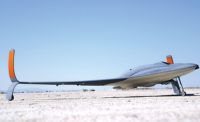Northrop Grumman, Sikorsky and other aerospace defense manufacturers recently unveiled state-of-the-art assembly lines that will enable them to boost capacity and improve efficiency.
Northrop Grumman, Sikorsky and other aerospace defense manufacturers recently unveiled state-of-the-art assembly lines will enable them to boost capacity and improve efficiency.
To ramp up production of the F-35 Joint Strike Fighter, Northrop Grumman Corp. recently unveiled an integrated assembly line (IAL) at its Palmdale, CA, plant that was inspired by the auto industry. “[It] will be the key factor in the future production of this aircraft,” says Mark Tucker, vice president of Northrop Grumman’s F-35 program.
The new line occupies a space near the current F-35 assembly line and includes automatic assembly tool systems, transportation systems and manufacturing systems, all controlled centrally and wirelessly by a factory communications system. Northrop Grumman expects to produce its first entire fuselage on the line early next year. Until then, work will continue using both the IAL and existing line.
“At its heart, the IAL is designed to drive new levels of efficiency into the manufacturing process, an endeavor that includes reducing process times, increasing precision and quality, and reducing the costs of production,” explains Tommy Tomlinson, senior vice president of production operations at Northrop Grumman Aerospace Systems.
“Our industry partner and our military customer are striving now more than ever before to improve the overall affordability of our products and services, and the IAL represents a major step forward for us in this effort,” adds Duke Dufresne, sector vice president and general manager of the Strike and Surveillance Systems Division of Northrop Grumman Aerospace Systems.
Final assembly of all F-35 jets is performed by Lockheed Martin in Fort Worth, TX, a process that includes mating the center fuselage to an aft fuselage produced by BAE Systems, and the forward fuselage, cockpit and wings produced by Lockheed Martin.
Sikorsky Aircraft Corp. has opened a new facility at its Florida Assembly and Flight Operations (FAFO) campus in West Palm Beach, FL, establishing experimental assembly line operations for the CH-53K heavy-lift helicopter.
“As we commence assembly line operations at FAFO, we are witnessing the dawn of a new age in rotorcraft development and construction,” claims Dennis Jarvi, vice president of Navy and Marine Corps Programs at Sikorsky. “The CH-53K helicopter is being digitally designed and manufactured. We have created virtual tools that will improve the learning process and identify and solve issues before they become costly delays in manufacturing.”
The 60,0000-square-foot CH-53K facility originally served as the home of Pratt & Whitney Rocketdyne (a sister division of United Technologies Corp.). “It has been completely updated to create a modern assembly are,” says Jarvi. “Overhead power and air dropdowns, new aircraft work stands, and overhead cranes have been installed to support aircraft final assembly and rotor head quality control assembly operations.”
The state-of-the-art facility also provides wireless data connections to all operators via plasma data screens. Digital operation sheets will aids assemblers working on a four-position flight line to produce the new aircraft.
Raytheon Co.’s recently broke ground on a new $70 million production facility in Huntsville, AL. When completed, the state-of-the-art facility will provide final assembly and testing for Raytheon's SM-3 and SM-6 missiles.
“This new factory will enable us to provide our Missile Defense Agency and U.S. Navy customers with even greater capability,” notes Taylor Lawrence, president of Raytheon Missile Systems. He says the 70,000 square-foot assembly plant will be constructed in two phases, each tied to SM-3 and SM-6 production contracts.
Military Aerospace Industry Invests in Manufacturing
Looking for a reprint of this article?
From high-res PDFs to custom plaques, order your copy today!








